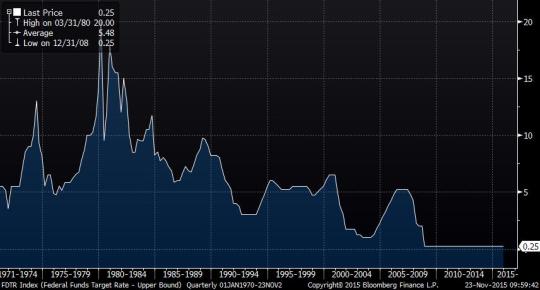
Economic bears welcome the imminent hike with grim glee. Now they can be certain that the Fed will not fail to push the economy into a recession.
Meanwhile, economic bulls and policy hawks point out that signs of reviving wage pressure suggest the Fed is well behind the curve.
The question I ask myself is not “which of those of factions are correct?” but “how should I position my portfolio given the growing dichotomy between the two camps?” If the skeptics of green shoots are correct and we are about to fall into some deflationary hell, I should do very well with my long bonds.
So, for the purpose of challenging my market position, let’s side with employment bulls. What will it take to lose money on being long US bond futures? Not for tomorrow, but on a 2-to-5 year horizon?
Clearly, if the fed hikes once or twice and NEVER goes again, the bonds will be cheap – you can earn 3%yield and fund at 0.50%. The point being that despite a likely volatile market-to-market, over the long-run, the economics has to win – the carry will just accrue. Chapters two and three of my book, The Next Perfect Trade, discuss such carry and value considerations in detail.
Barring US sovereign default concerns, to put pressure on profitability of bonds bought with 3% yield, the overnight rate would have to go above 3% AT SOME POINT. But what else will have to happen in this case?
Along with long US bonds, I am also long the US dollar. I have discussed the interplay between those two trades multiple times. I consider this combination in 2014 to have been one the two greatest macro trades (a “perfect trade”) in all history of markets. But I also wrote in 2015 the position was not looking quite so easy. Indeed, in the months following the completion of the book the strategy has meandered, making a trader rely on tactical skills to deliver any profit.
As of today, the long dollar trade is getting crowded in the anticipation of the policy “lift-off”. So it is not inconceivable that the original hike is already priced in and one or two hikes will not really move the needle.
But what about going all the way to 3% while the other major CBs are still easing? One may argue that hiking cycles in the past have not always coincided with broad dollar strengthening. But in this particular environment, I have trouble imaging the dollar not continuing its uptrend in the event of such a dramatic hiking cycle.
It is important to remember that US is not an export economy and a strong domestic currency may at first be only a very moderate drag on the GDP. Thus a cyclical recession might not be imminent.
However, certain things are likely in a strong dollar environment:
Suppressed commodity prices
- Labor outsourcing
- Emerging markets debt troubles
- Chinese currency decoupling and devaluation
- Deflationary shocks coming from overseas
None of those things make me think of an inflationary spiral.
The historical pattern of the last few decades has been a fairly regular alternation of easing and tightening cycles with each easing cycle pushing rates into a lower and lower territory.

As I have mentioned, I am agnostic about the current strength of the US economy and I am not trying to argue that we are about to enter a recession. But I do assume that a recession will happen sometime in the next few years, and most likely soon after the end on the tightening cycle, as the historical pattern indicates.
In the event of significant rise in interest rates I don’t expect a break in the secular disinflation cycle; in fact, I expect the next easing wave to take us into the negative rates territory (NIRP). Hence, when David Schawel (@DavidSchawel) conducted a poll on the Fed Funds rate three years from now – I called for negative one percent (-1.00%). Not that I have any conviction about this level or timing; I just think it is at least as likely as any other outcome.
So with the Fed getting ready to move, I am getting more constructive again about the long US dollar/long US bonds. I see two longer-term scenarios.
1. One and done. Massive gains on the bonds. Dollar unclear, but still supported by policy divergence.
2. Protracted tightening. Gains on the dollar. Possible pull-back on bonds, mitigated by curve flattening. Eventually, massive gains when the easing cycle plays out.
In the interim, one can expect all sorts of short-term market-to-market volatility, which may be the price to be paid for the high likelihood of longer-term success.
Image: Ruth Hartnup Beware of red men dive bombing off cliffs


